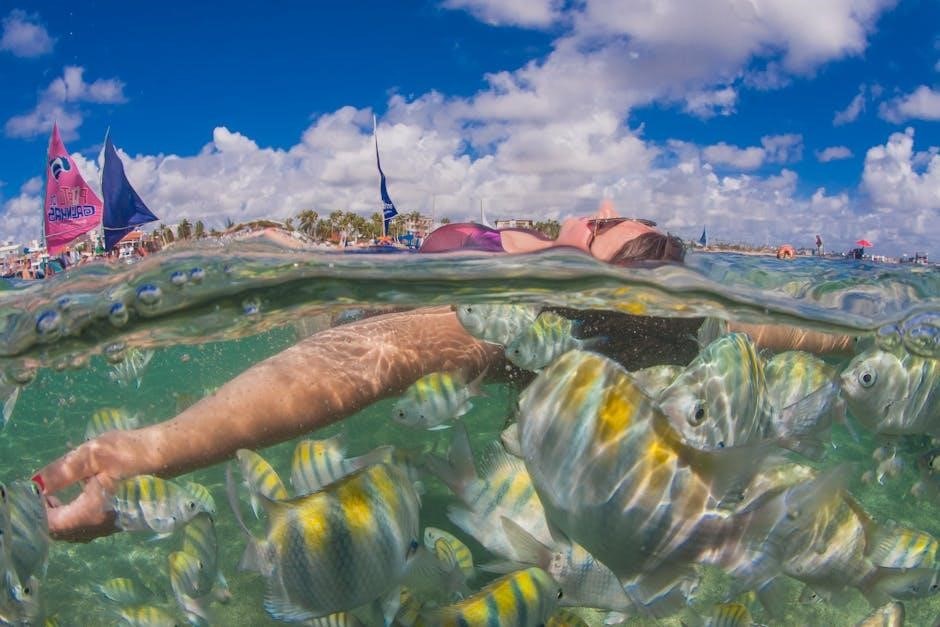lifesaving society swim levels pdf

Lifesaving Society Swim Levels PDF: A Comprehensive Guide
The Lifesaving Society’s Swim for Life program is a comprehensive system
designed to teach Canadians of all ages how to be safe and proficient in
the water. This guide provides an overview of the program’s structure.
The Lifesaving Society’s Swim for Life program stands as a cornerstone of
water safety education in Canada. As a charitable organization‚ the
Lifesaving Society has been dedicated to preventing drowning and
water-related injuries since its inception. The Swim for Life program is
designed to be accessible‚ flexible‚ success-oriented‚ and‚ most
importantly‚ fun. The program seamlessly integrates into the Canadian Swim
Patrol program and further into the Lifesaving Society’s vocational
training awards.
The Swim for Life program focuses on teaching fundamental swim strokes and
skills needed to achieve the Swim to Survive standard. Instructors ensure
that swimmers receive ample in-water practice during each lesson. The
program also incorporates Water Smart drowning prevention messages into all
swimmer levels.
The program is designed for all ages and abilities and emphasizes
developing solid swimming strokes and skills.
Objectives of the Swim for Life Program
The primary objective of the Lifesaving Society’s Swim for Life Program is
to equip individuals with the skills and knowledge necessary to be safe and
proficient swimmers. The program aims to prevent drowning and
water-related injuries through comprehensive training and education. Swim
for Life promotes the development of fundamental swim strokes and skills‚
enabling participants to achieve the Swim to Survive standard.
Another key objective is to foster healthy habits and promote physical
fitness through swimming. The program encourages participants to stay active
and develop lifelong skills that contribute to their overall well-being. By
integrating Water Smart drowning prevention messages into all swimmer
levels‚ Swim for Life emphasizes the importance of water safety awareness.
The Lifesaving Society strives to make the Swim for Life program accessible
and enjoyable. The program is designed to accommodate various ages‚
abilities‚ and learning styles.
Water Smart Integration
The Lifesaving Society’s Swim for Life program places a strong emphasis on
integrating Water Smart drowning prevention messages into every level.
These messages are designed to educate participants about the risks
associated with water activities and how to minimize them. Water Smart
principles are woven into the curriculum‚ reinforcing safe practices and
promoting responsible behavior around water.
Through Water Smart integration‚ participants learn about various water
hazards‚ such as currents‚ waves‚ and underwater obstacles. They also
acquire knowledge about the importance of supervision‚ wearing appropriate
safety equipment‚ and swimming in designated areas. The program teaches
individuals how to recognize and respond to emergencies‚ including rescue
techniques and calling for help. By incorporating Water Smart education‚ the
Swim for Life program aims to create a generation of water-aware and
water-safe individuals.
This comprehensive approach to water safety is crucial in preventing
drowning and promoting responsible aquatic behavior.

Swim Level Structure and Progression
The Swim for Life program has a structured progression‚ starting with
Parent & Tot‚ advancing through Preschool‚ Swimmer levels‚ and the Canadian
Swim Patrol.
Parent & Tot Program (6-36 Months)
The Parent & Tot program is designed for children aged 6-36 months‚
requiring parental participation. It focuses on introducing infants and
toddlers to the water in a safe and playful environment. These levels aim
to build comfort and confidence in the water through songs‚ games‚ and
gentle activities. Parents learn how to safely handle their children in the
water‚ fostering a positive association with swimming.
Skills include entries and exits with assistance‚ front and back floats with
support‚ and gentle submersion. The program emphasizes water smart
education for parents‚ teaching them about water safety and drowning
prevention strategies. It provides a foundation for future swimming skills
and promotes early childhood development through aquatic exploration. The
classes are structured to be engaging and enjoyable for both parents and
children.
Preschool Program (3-5 Years)
The Preschool Program is tailored for children aged 3-5 years‚ building upon
the foundation established in the Parent & Tot program. This level
introduces more independent water skills while still maintaining a fun and
supportive learning environment. Children learn basic water safety rules and
begin to develop fundamental swimming techniques.

Skills taught include assisted entries and exits‚ blowing bubbles‚ front and
back floats‚ and kicking. The program emphasizes increasing comfort and
confidence in the water‚ encouraging children to explore and play safely.
Instructors use games‚ songs‚ and positive reinforcement to engage
preschoolers and foster a love for swimming. Water Smart messages are
integrated into each lesson. By the end of the program‚ children will have
a solid foundation for advancing to the Swimmer levels.
Swimmer Levels (5+ Years)
The Swimmer levels are designed for children aged 5 years and older‚
building upon the skills learned in the Preschool program. This program
focuses on developing progressively more advanced swimming techniques‚ water
safety knowledge‚ and personal fitness. Each level introduces new challenges
and skills‚ ensuring continuous improvement and engagement.
Swimmer levels emphasize proper stroke mechanics‚ including front crawl‚ back
crawl‚ and breaststroke arms with breathing. Participants learn safe entries
and exits‚ deep water support‚ and underwater skills. Water Smart drowning
prevention messages are integrated into each level‚ teaching children how to
recognize and respond to potential hazards. The program fosters lifelong
healthy habits by promoting physical activity and water safety awareness.
Progressions accommodate beginners and those wanting to build on the basics.
Canadian Swim Patrol Program
The Canadian Swim Patrol program is a 3-level program designed to provide
enriched training for swimmers who wish to develop their strokes and skills
further while having fun learning about lifesaving. This program acts as a
bridge between the Swimmer levels and the Lifesaving Society’s lifesaving
and vocational training awards. It builds upon the fundamental skills
acquired in the Swim for Life program‚ preparing participants for more
advanced training.
The Swim Patrol program focuses on developing swimming proficiency‚ fitness‚
and lifesaving knowledge. Participants learn about water rescue techniques‚
first aid‚ and injury prevention. This program is designed for those who
enjoy swimming and are interested in developing skills that can be used in
lifesaving and aquatic leadership roles. It provides a challenging and
rewarding experience‚ fostering a sense of responsibility and community
involvement. The program encourages the development of leadership skills.

Key Skills Developed in Swimmer Levels
Swimmer levels focus on developing key skills such as safe entries‚ deep
water support‚ underwater skills‚ and fundamental swim strokes‚ ensuring
children learn to swim before getting in too deep.
Safe Entries and Exits
The Lifesaving Society’s Swim for Life program places a strong emphasis on
teaching safe entries and exits from the water‚ a fundamental skill for
swimmers of all levels. Starting with basic assisted entries and exits in
shallow water‚ the program gradually progresses to more advanced techniques
as swimmers gain confidence and competence. These skills are not only
crucial for preventing accidents but also for building a swimmer’s overall
comfort and security in aquatic environments.
The program ensures participants learn how to enter the water safely in
various scenarios‚ including jumping into chest-deep water with assistance.
Learning to exit safely is equally important‚ and the curriculum covers
techniques for exiting from different water depths and pool edges. The
focus is on teaching swimmers to be aware of their surroundings and to
assess potential hazards before entering or exiting the water. By
mastering these skills‚ swimmers can confidently navigate aquatic
environments and minimize the risk of injury.
Deep Water Support and Skills
The Swim for Life program emphasizes the development of essential deep-water
support and skills‚ crucial for water safety and confidence. Swimmers learn
techniques for maintaining buoyancy and staying afloat in deep water‚
enabling them to conserve energy and remain safe if they find themselves in
unexpected situations. These skills begin with assisted support and
gradually progress to independent floating and treading water.
The program incorporates various exercises to build strength and endurance
in deep water. Swimmers learn how to use their arms and legs effectively
to stay afloat‚ as well as how to conserve energy by adopting different
floating positions. Treading water is a key component‚ teaching swimmers
how to maintain their position and keep their head above the surface for
extended periods. These skills are not only vital for safety but also
provide a foundation for more advanced swimming techniques and rescue
skills.
Underwater Skills
The Lifesaving Society’s Swim for Life program dedicates significant
attention to developing underwater skills‚ fostering confidence and
competence beneath the surface. These skills are essential for water safety
and enhance a swimmer’s ability to respond effectively in various aquatic
scenarios. The program introduces swimmers to basic techniques like blowing
bubbles and opening their eyes underwater.
As swimmers progress‚ they learn more advanced skills such as retrieving
objects from the bottom of the pool and performing underwater swims. These
exercises improve breath control‚ body orientation‚ and spatial awareness.
The program ensures that swimmers are comfortable and capable of navigating
underwater environments. Furthermore‚ underwater skills contribute to
developing streamlining techniques‚ which are important for efficient
swimming strokes. The program emphasizes safety and proper techniques to
ensure a positive and safe learning experience.
Fundamental Swim Strokes
The Lifesaving Society’s Swim for Life program places a strong emphasis on
teaching fundamental swim strokes. It ensures participants develop efficient
and effective swimming techniques. The program systematically introduces
swimmers to various strokes‚ beginning with the basics and progressing to
more complex movements. Front crawl is often the initial stroke taught‚
focusing on body position‚ arm action‚ and breathing.
Back crawl is also introduced early on‚ emphasizing proper body alignment
and alternating arm movements. As swimmers advance‚ they learn the
breaststroke‚ which involves a coordinated sequence of arm pulls‚ leg kicks‚
and breathing. The program also covers the elementary backstroke‚ a
resting stroke that promotes relaxation and efficient movement through the
water. Instructors provide detailed guidance and feedback to help swimmers
refine their stroke techniques. Drills and exercises are used to improve
specific aspects of each stroke‚ such as arm pull‚ kick‚ and body rotation.

Lifesaving Society Resources
The Lifesaving Society offers a wealth of resources. These resources support
participants and instructors involved in their various programs. These
resources ensure effective and safe water safety education.
Finding Swim Level Conversion Charts
Locating the right swim level for your child can be simplified using the
Lifesaving Society’s conversion charts. These charts are invaluable for
families transitioning from other swim programs like the Red Cross. They
help bridge the gap and ensure proper placement within the Swim for Life
program. These charts take into account prior skills and experience.
You can typically find these charts on the Lifesaving Society’s official
website for your province or territory. Many local swim schools and
recreation centers also provide these charts. These charts will ensure that
your child is in the most appropriate class.
If your child previously completed levels in the Red Cross program‚ these
charts help determine the corresponding Lifesaving Society level. This
ensures a smooth transition and continued progress. Refer to the Lifesaving
Society BC & Yukon website if you need any certification information.
Accessing Test Sheets and Program Information
Gaining access to Lifesaving Society’s test sheets and program information
is crucial for instructors‚ parents‚ and swimmers alike. These resources
provide a clear understanding of the skills and requirements for each swim
level. Test sheets outline the specific criteria that swimmers must meet to
advance to the next level. This is important for swim instructors to know.
The Lifesaving Society’s website is the primary source for these
materials. You can find detailed program descriptions‚ skill breakdowns‚ and
assessment guidelines. Local swim instructors and recreation centers often
have access to these resources. This will help them track progress.
For example‚ the Lifesaving Society AB and NWT websites offer downloadable
test sheets. These resources allow instructors to effectively evaluate
swimmers’ abilities and provide targeted feedback.
